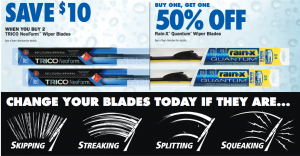Windshield Wipers Get our Advice
What You Need to Know About Replacing Your Windshield Wipers
Windshield wipers are an important safety feature for your vehicle. A good pair of wipers will ensure that you have good visibility during heavy rain, snow, sleet, hail, and ice. Here’s what you need to know about wipers and blades before you head to an auto parts store to buy your replacement wipers.

What are the signs that you need to replace your wipers and blades?
Look for these six signs that tell you it’s time replace your wipers.
- Change of seasons. You should change your wipers twice a year, in the fall and in the spring. Change your wipers in the fall to prepare for winter, especially for heavy snow and ice. Get a fresh pair in the spring to replace blades that may be cracked from freezing or damage by heavy snow and ice. You’ll be prepared for the heavy rainy season. If you’re in an area with extreme conditions, consider using season-specific wipers.
- Noise. If you hear squeaking, squealing, chattering, flapping or dragging sounds, you need to check and consider replacing your blades even if they seem to be working well. These sounds let you know that the rubber is starting to break down or that the blades are cracking or coming loose from the wiper arm.
- Visible damage. Visually inspect the blades for cracked or torn rubber. Look for missing and loose pieces on the blade.
- Streaks and film on the glass. Look for areas where the wiper doesn’t clean the glass. If you have oily or grimy streaks on the windshield after spraying washer fluid or cleaning the glass and blades manually, it’s time to replace the wipers.
- Poor contact. If the wipers aren’t cleaning every part of the glass, check for worn rubber on the blades and for any problems with the wiper frame or arm.
- Damaged wiper frame. Check the wiper frame after heavy ice and whenever you go through a car wash. If the frame is bent, the wiper blade can get damaged and not make proper contact with the windshield glass.
If you replace the wipers and continue to have problems, there may be a mechanical problem with the wiper arm, gearbox, module or motor. The symptoms of a mechanical failure with your wipers include:
- The wiper arm won’t move.
- The arm is bent or broken.
- The arm gets stuck mid-way your windshield.
- You hear grinding or churning noises when you operate the wipers.
What are the different types of wiper blades?
There are three basic types of wipers available for use on passenger vehicles including conventional, beam and hybrid blades. There are also premium or high-performance wipers.
Conventional wiper blades, made from durable metal materials, are designed to be an economical choice. They clear the largest part of your windshield ensuring adequate visibility in most conditions. Conventional wipers may not stand up to ice build-up and wind lift, winter blades include an additional rubber boot to handle extreme weather conditions.
Beam wiper blades are aerodynamically designed to resist wind lift. They also do a better job of handling ice and snow. Beam blades are lightweight, frameless, and they prevent streaking better than conventional blades. For extreme snow and ice, winter beam blades are designed to perform in temperatures as low as -40 degrees Celsius.
Hybrid wiper blades are designed for maximum performance by combining the best features of conventional and beam blades. Hybrid blades feature an aerodynamic cover made of hard plastic or soft rubber, combined with a metal frame.
Premium or high-performance wiper blades cost more but offer longer life and may be more visually appealing than traditional wipers. They are made of silicone, double-rubber technology and a spring-steel band that allows the blades to adapt to the curve of your windshield.
How do you select the right wipers and blades for your vehicle?
- Check your owner’s manual for the correct wiper blade specifications. In many cases, the driver, passenger, and rear wipers use different size blades.
- If you don’t have an owner’s manual, know that make model, year and trim level of your vehicle.
- Some wiper manufacturers offer an OEM option that is designed to fit and perform like your original factory installed wipers.
- Your auto parts retailer can look up the specifications for you and find the right wiper in stock.

Wipers coupons, Save $10 or 50% off second wiper
How do you replace wiper blades?
- You’ll need the correct size wipers, a small screwdriver, and a cloth to protect your windshield.
- Carefully lift the wiper arm off the windshield. Extend the arm toward the front of your vehicle and ensure that it stays in place.
- Alternatively, if the wiper arm does not lift away from the windshield, turn on the ignition and engage the wipers. Turn off the engine when the blades are standing horizontally on the windshield.
- Place the cloth between the blades and the glass to protect against cracking and other damage.
- On most newer vehicles, locate the release tabs on the blade assembly. Press the tabs to remove the blade from the assembly arm. On older vehicles, you may need to use the screwdriver to loosen the screw on the blade assembly arm.
- Install the new blades according to the instructions. Make sure the release tabs are secured or the screw is secured.
- Remove the protective cloth and lower the wiper arm back onto the windshield.
- Turn on the wipers to ensure proper operation. Use a small amount of washer fluid to ensure that the blade clears the glass completely.
Maintaining Your Wiper Blades
To maintain your new blades, use a scraper or snow brush rather than using your windshield wipers to remove thick ice and heavy snow. Although wipers need to be replaced every six months, don’t try to stock up on blades now and use them later. That’s because wipers are subject to environmental stress even when they’re not installed on your vehicle. Storing them in high heat or very low colder temperatures can cause the rubber to warp or crack before you ever install them. It’s best to purchase your wiper blades in-season when you’re ready to replace them.
